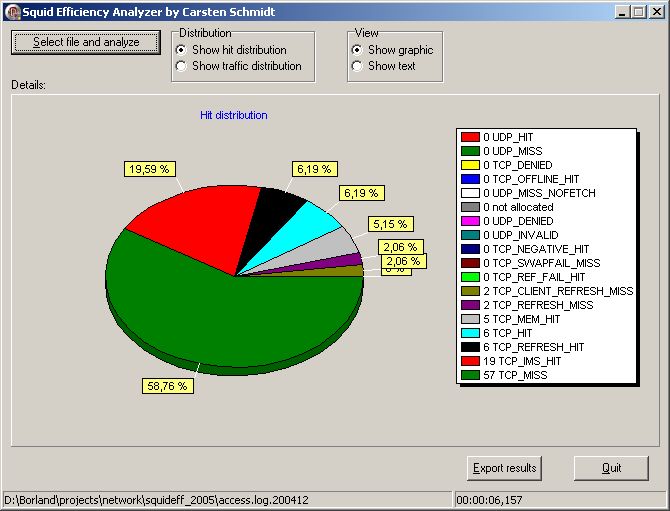Squid Efficiency Analyzer Crack [Latest]
Squid Efficiency Analyzer – open a log file and start analysis. Wait for the results which are shown in an table (detailled view) and in a text field (summary). You may then export the results to a file. Squideff checks every line of the Squid log file and assigns occurrence and traffic to the different cache codes. Afterwards, traffic from cache and internet are calculated. For this project I have decided to work with signed 64-bit integers in order to work with large numbers. Despite that, it may be possible that values exceed this range. In that case, please tell me (not that I know what to do about it). Theese codes are provided as being data coming from the cache: TCP_HIT TCP_REFRESH_HIT TCP_REF_FAIL_HIT TCP_IMS_HIT TCP_MEM_HIT TCP_OFFLINE_HIT UDP_HIT The following codes are calculated as data coming from the internet: TCP_MISS TCP_REFRESH_MISS TCP_CLIENT_REFRESH_MISS TCP_SWAPFAIL_MISS UDP_MISS The rest is shown as not considered for efficiency: TCP_NEGATIVE_HIT TCP_DENIED UDP_DENIED UDP_INVALID UDP_MISS_NOFETCH NONE

Squid Efficiency Analyzer Crack + Full Version Free Download X64 Latest
This is the Squid session log analyzer. Please note that the list below is not complete. The logged data are divided in percents. See table for detailed view Percents sum up to 100% with no decimal points. A short summary of values is available in the text field below. You may review the data in a table, or choose to review in summary mode. The same “full view” is also available in both modes. A screenshot of the “full view” is shown below. The “full view” is exactly the same as the table view of that mode, except for the indicated row in which the data are shown. The “summary view” is just a short-cut through the full view in order to get to the summary of those data. A screenshot of the “summary view” is shown below. In summary mode, the percentage of hits to various cache codes are just shown, as they are in the full view. The table view in summary mode shows more detailed data (however, it might not be available in all modes, as described in the table below). The data of the “full view” are exported automatically to a file in all modes except the text-field summary mode. The data of the “summary view” is exported in the text-field summary mode only. Download: The source code is in java. It runs on Linux, and does not depend on Squid version. There are no GUI, therefore no runtime error or other delays are possible. When using the summary view, you will be prompted for the file name in which you wish to write the results. You can find the source code here. The log analyzer is a bit unstable (it has many backdoors). I don’t have a lot of time to support it. See here for the version of today. Usage: You may start it by invoking the program as follows: java SquidEffAnalysis [options] log_file [sub_options] The log_file is your Squid log file. sub_options are the options that apply to that specific log_file, e.g. -i for the squid.conf file. You may specify a log file for the ‘full view’ and summary mode
Squid Efficiency Analyzer
Windows 32 bit Requires a working squid.conf or a text file without any specially-written configurations (i.e. ‘INCLUDE…’ lines) Requires squid’s log files to be accessible. Current version: 0.0.1 squid.conf: # Default Cache Directory for Squid # # Put your configuration files in this directory, so Squid can use # them without modifying the main config file. # # Example: # # log /var/log/squid.log # pidfile /var/run/squid.pid # # The directory ‘/var/lib/squid’ is automatically created and # populated by Squid if it has to be created. See section 2.1 # on how to customize the configuration and directory settings. # # NOTE: if you want to customize the cache directory, you may # have to modify the main config file to set the dir # setting to ‘/path/to/your/dir’! #dir /var/lib/squid # # Default Cache Log File Name # # If you do not want Squid to create log files you will have # to modify the main config file. # # If you do want to customize the log file name, you will have # to modify the main config file. # # NOTE: you may have to modify the main config file to set the log # file name to something else other than “/dev/null”! #logfile /dev/null # # Swap-free Cache Memory Size # # You may have more than one instance of Squid running at the same time # on a single machine. If you think you might, change this. # # NOTE: This setting will do no good unless you uncomment the # cacheSize section below. #swapFree 1536000 # This section controls the number of “invalidation requests” a cache # server sends to the 2f7fe94e24
Squid Efficiency Analyzer (Latest)
Export the results as CSV: Click the button Export as CSV. Select the correct encoding as required by your CSV program, this is UTF-8 by default. Export the results as HTML: Click the button Export as HTML. Select the correct encoding as required by your HTML program, this is UTF-8 by default. Export the results as Excel: Click the button Export as Excel. Select the correct encoding as required by your Excel program, this is UTF-8 by default. Imports the data from a file: Click the button Imports from a file. You may use a file, a remote FTP server, or a local folder to import data to analyse. Open a log file and start analysis: Open a log file and start analysis. Wait for the results which are shown in an table (detailled view) and in a text field (summary). You may also export the results to a file. DNS Misconfigurations What are DNS Misconfigurations? DNS (Domain Name System) is an internet service that translates names on the internet to addresses that your computer can use to reach those names. It does so by the use of entries in a database that is maintained by a central DNS server. The common domain names are: www (http), gmail.com, google.com, microsoft.com, yahoo.com, etc. They are mapped to their Internet Protocol (IP) addresses in the DNS database. DNS translates the domain name into its corresponding IP address using a protocol called the Internet Protocol Address (IP). Why are DNS Misconfigurations a problem? A DNS misconfiguration can lead to problems in your computer that slow your surfing speed or access to information. Internet Speed suddenly decreases or you can be blocked to a website because they use IP restrictions. The DNS database has to be updated by an Internet Service Provider (ISP) for every IP address change. There is a competition in the internet and some internet users believe that they will lose their internet access if the DNS database is changed for more than every hour or so. The DNS changes for an IP address happen when an ISP changes the IP address of a server. When this happens, it is important to update the DNS database because the DNS service has to reroute your internet traffic to the new IP address. However, some ISP
What’s New In Squid Efficiency Analyzer?
Solve your cache problems! Squid Efficiency Analyzer is a simple utility which can check the cache efficiency of your Squid Server. Squid Efficiency Analyzer uses integer hashing to identify cache problems and to calculate the cache efficiency. Therefore it is not only exact but also efficient and very fast. The following cache-related statistics are available (tested with squid 2.7.STABLE5, from Oink.com): • cache hit count (TCP_HIT) • cache hit ratio (TCP_HIT/TCP_HIT+TCP_REFRESH_HIT) • cache hit ratio with only TCP_HIT (TCP_HIT/TCP_HIT+TCP_REFRESH_HIT) • cache hit ratio with only TCP_REFRESH_HIT (TCP_HIT/TCP_HIT+TCP_REFRESH_HIT) • cache hit ratio with only TCP_REFRESH_FAIL_HIT (TCP_HIT/TCP_HIT+TCP_REFRESH_HIT+TCP_REFRESH_FAIL_HIT) • cache hit ratio without TCP_REFRESH_HIT (TCP_HIT/TCP_HIT+TCP_REFRESH_FAIL_HIT) • cache hit ratio without TCP_REFRESH_FAIL_HIT (TCP_HIT/TCP_HIT+TCP_REFRESH_HIT+TCP_REFRESH_FAIL_HIT) • number of cache invalidations (TCP_NEGATIVE_HIT) • number of cache reloads (TCP_DENIED) • number of cache mismatches (TCP_DENIED) • number of cache swap failures (TCP_SWAPFAIL_HIT) • number of cache invalidations due to negative cookies (TCP_NEGATIVE_HIT) • number of cache misses (TCP_MISS) • number of cache hits (TCP_HIT) • number of cache reloads due to negative cookies (TCP_DENIED) • number of cache refesh due to negative cookies (TCP_REFRESH_DENIED) • number of cache conflicts due to negative cookies (TCP_RE
https://wakelet.com/wake/IMvqnh_3mFHWuLgTDjZSX
https://wakelet.com/wake/r25rXzK8yLcqNzobrSAnI
https://wakelet.com/wake/1k0qYs_AvczW-Q8SivbaS
https://wakelet.com/wake/59ArcahM89CHINzqyTICQ
https://wakelet.com/wake/crtqEcO3R1pgQfHQ2F-fD
System Requirements For Squid Efficiency Analyzer:
Windows: Mac: Minimum: Intel i5 3570 / AMD FX 8150 / NVIDIA GTX 970 Mac Pro Dual G5 2011-2011 Recommended: Intel i7 4960X / AMD FX 8350 / NVIDIA GTX 1060 Auction Mode (For those with low end graphics cards) Intel i7 4960X / AMD FX 8350 / NVIDIA GTX 1060
https://www.5etwal.com/abacre-cloud-retail-point-of-sale-crack-free-download/
https://72bid.com?password-protected=login
http://jameschangcpa.com/advert/image-for-dos-1-98-license-key-download-for-windows/
https://www.topperireland.com/advert/account-chef-crack-free-download-mac-win-final-2022/
https://unsk186.ru/aretales-voyager-crack-free-download-mac-win/
https://innovacioncosmetica.com/bestsync-crack-with-product-key-download-2022/
https://tgmcn.com/urban-dictionary-crack-download-pc-windows/
http://goldeneagleauction.com/?p=50124
https://www.publishing.wang/archives/6550
http://applebe.ru/2022/07/13/a-folder-locker-crack-free-license-key/
http://yotop.ru/2022/07/13/project-hello7000-latest-2022/
https://amnar.ro/move-mouse-for-windows-10-crack-download-mac-win-latest-2022/
https://richard-wagner-werkstatt.com/2022/07/13/nemo-documents-5-0-510/
https://rocketchanson.com/advert/rar-to-zip-converter-crack-free/
http://wavecrea.com/?p=13002
